Metal imalat dünyası bir makine senfonisidir ve her bir alet hammaddelerin hayatımızın yapı taşlarına dönüştürülmesinde çok önemli bir rol oynar. C profil yapma makineleriAşık rulo şekillendirme makineleri olarak da bilinen bu makineler, metal levhaları inşaattan altyapıya kadar her alanda uygulama alanı bulan belirgin C şekilli profillere dönüştürmekten sorumlu olan bu orkestradaki hayati araçlardır.
Ancak her türe uygun bir gitar olduğu gibi, her ihtiyaca uygun bir C profil makinesi de vardır. Bu kılavuz, mevcut farklı C profil makinelerini, işlevlerini ve üstün oldukları uygulamaları inceleyerek projeniz için mükemmel seçimi yapmanızı sağlar.
İşlev, Uygulamalar ve Faydalar
Düz bir ağa ve dik açılarla çıkıntı yapan iki flanşa sahip bir metal kanal hayal edin - bu bir C profilinin özüdür. C profil yapım makineleri, tipik olarak çelik olan metal levhaları alır ve bir dizi silindir kullanarak bunları hassas bir şekilde bu C şeklindeki forma büker. Bu silindirler metali aşamalı olarak şekillendirerek üretim boyunca tutarlı ve doğru profiller elde edilmesini sağlar.
C profilleri uzun bir uygulama listesine sahiptir. İnşaatta, çatıları ve duvar kaplamalarını destekleyen hafif ancak sağlam aşıklar olarak hizmet ederler. Bir binanın metal iskeletini hayal edin - C profilleri her şeyi bir arada tutan iskelet destek sistemi olarak işlev görür. Ayrıca kapı ve pencere çerçeveleri, makaslar ve hatta mobilya bileşenlerinin oluşturulmasında da etkilidirler. Çok yönlülükleri inşaatın ötesine geçerek otomotiv parçaları, tarım ekipmanları ve hatta güneş paneli montaj sistemlerinde kullanım alanı bulur.
C profilleri kullanmanın çok sayıda faydası vardır. Olağanüstü güç-ağırlık oranı sunarlar, yani ağırlıklarına göre inanılmaz derecede sağlamdırlar. Bu da malzemelerin verimli kullanımı ve maliyet tasarrufu anlamına gelir. Ayrıca, C şeklindeki tasarımları mükemmel sağlamlık sağlayarak yapısal destek gerektiren uygulamalar için mükemmeldir. Ayrıca kurulumu ve çalışması nispeten kolaydır, bu da cazibelerini daha da artırır.
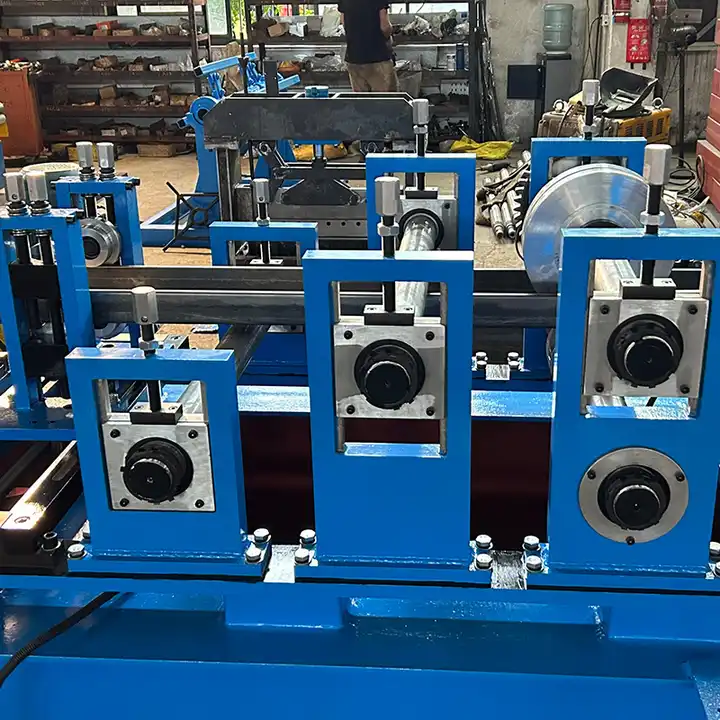
Ortak C Profil Yapma Makinesi Türleri
Artık C profilini ve uygulamalarını anladığımıza göre, mevcut farklı C profil yapma makinelerini inceleyelim:
- Makaralı Pres C-Şekilli Çelik Şekillendirme Makinesi: Bu, C profil dünyasının beygiridir. Her biri metal levhayı istenen C profiline kademeli olarak şekillendiren bir dizi silindir kullanır. Bu makineler yüksek üretim hızları sunarak onları büyük ölçekli projeler için ideal hale getirir. Farklı boyutlarda ve kalınlıklarda C profillerinin oluşturulmasına izin veren çeşitli konfigürasyonlarda gelirler.
Avantajlar: Yüksek üretim hızı, profil boyutu ve kalınlığında çok yönlülük.
Dezavantajlar: Kurulumu karmaşık olabilir ve yetenekli operatörler gerektirebilir.
- Hidrolik C-Şekilli Çelik Şekillendirme Makinesi: Bu tip makineler metal sacı şekillendirmek için hidrolik basınç kullanır. Hidrolik, şekillendirme işlemi üzerinde hassas kontrol sağlayarak son derece hassas C profilleri elde edilmesini sağlar. Bu makineler, karmaşık profiller veya sıkı toleransların gerekli olduğu durumlar için çok uygundur.
Avantajlar: Hassas kontrol, karmaşık profiller ve dar toleranslar için idealdir.
Dezavantajlar: Genel olarak silindir pres makinelerine kıyasla daha yavaş üretim hızı, daha yüksek ön maliyet.
- Kompozit C-Şekilli Çelik Şekillendirme Makinesi: Bu yenilikçi makine, silindir şekillendirme ve zımbalama prensiplerini birleştirir. Metali sadece bir C profiline şekillendirmekle kalmaz, aynı zamanda delikleri ve kesikleri de delebilir. Bu da ayrı bir zımbalama istasyonuna olan ihtiyacı ortadan kaldırarak üretim sürecini kolaylaştırır ve zamandan tasarruf sağlar.
Avantajlar: Kolaylaştırılmış üretim süreci, ayrı delme istasyonu ihtiyacını ortadan kaldırır.
Dezavantajlar: Geleneksel silindir pres makinelerine kıyasla daha yüksek başlangıç maliyeti, özel bakım gerektirebilir.
C Profil Yapma Makinesi Seçerken Dikkat Edilmesi Gereken Temel Hususlar:
İşte bir C profil yapma makinesi seçerken göz önünde bulundurulması gereken bazı önemli faktörler:
- Üretim Hacmi: Yüksek hacimli projeler bir silindir pres makinesinin hızından faydalanabilirken, daha düşük hacimli işler hidrolik bir makineyi daha uygun maliyetli bir seçenek haline getirebilir.
- Profil Karmaşıklığı: Sıkı toleranslara sahip karmaşık profillere ihtiyacınız varsa, hidrolik bir makine gerekli olabilir. Daha basit profiller için bir silindir pres makinesi yeterli olacaktır.
- Bütçe: Silindirli pres makineleri genellikle en bütçe dostu seçenektir, hidrolik ve kompozit makineler ise daha yüksek bir ilk yatırımla gelir.
- Operatörlerin Beceri Seviyesi: Silindir pres makinelerinin kurulumu ve çalıştırılması hidrolik makinelere kıyasla daha karmaşık olabilir.
Tedarikçi ve Fiyatlandırma Hususları
| Faktör | Açıklama |
|---|---|
| Tedarikçi Seçimi | Kalite, kapasite ve maliyet gereksinimlerinizi karşılayan nitelikli tedarikçilerden oluşan bir havuz belirleyin. Potansiyel tedarikçileri çevrimiçi dizinler, sektörel yayınlar ve tavsiyeler aracılığıyla araştırın. Fiyatlandırma ve koşulları karşılaştırmak için birden fazla tedarikçiden teklif isteyin. |
| Tedarikçi Değerlendirmesi | Potansiyel tedarikçileri ürün kalitesi, fiyatlandırma, güvenilirlik ve müşteri hizmetleri gibi faktörlere göre değerlendirin. Ürün kalitesini değerlendirmek için numune talep edin. Tedarikçinin referanslarını ve zamanında teslimat ve kalite kontrol konusundaki sicilini kontrol edin. Tedarikçinin müşteri hizmetleri duyarlılığını ve teknik destek yeteneklerini değerlendirin. |
| Müzakere ve Sözleşme | Kısa listeye alınan tedarikçilerle fiyatlandırma, şartlar ve koşulları müzakere edin. Gereksinimlerinizi ve spesifikasyonlarınızı net bir şekilde iletin. Erken ödeme veya toplu alımlar için indirimler gibi uygun ödeme koşullarını müzakere etmeyi hedefleyin. Fiyatlandırma, ödeme koşulları, teslimat zaman çizelgeleri, kalite standartları ve garanti bilgilerinin ana hatlarıyla belirtildiğinden emin olmak için sözleşmeyi dikkatlice inceleyin. |
| Ödeme Koşulları | Ödeme yöntemleri, vade tarihleri ve indirimler dahil olmak üzere net ödeme koşulları belirleyin. Nakit akışınızla uyumlu ve işletme sermayenizi optimize eden ödeme koşullarını müzakere edin. Ödeme yöntemini belirlerken erken ödeme indirimleri, kredi kartı ücretleri ve banka havalesi maliyetleri gibi faktörleri göz önünde bulundurun. |
| Minimum Sipariş Miktarı (MOQ) | Tedarikçi tarafından istenen minimum sipariş miktarını (MOQ) belirleyin. MOQ, bir tedarikçinin tek bir siparişte satmaya istekli olduğu en küçük mal miktarıdır. MOQ'u anlamak, envanter satın alımlarınızı planlamak ve fazla stoktan kaçınmak için önemlidir. Bazı durumlarda, uzun vadeli bir tedarik anlaşması yaparsanız daha düşük bir MOQ için pazarlık yapabilirsiniz. |
| Fiyat Dalgalanmaları | Piyasa koşulları, döviz kurları veya hammadde maliyetlerinden kaynaklanan potansiyel fiyat dalgalanmalarını göz önünde bulundurun. Belirli bir dönem için sabit fiyatlandırma veya piyasa değişikliklerine göre ayarlanan endeks bazlı fiyatlandırma gibi potansiyel fiyat dalgalanmalarını hesaba katan fiyatlandırma modelleri üzerinde anlaşın. Belirli bir dönem için fiyatlandırmayı sabitlemek için tedarikçilerle uzun vadeli sözleşmeler yapmayı da düşünebilirsiniz. |
| Teslim Süresi | Tedarikçinin ürünlerinizi üretmesi ve teslim etmesi için gereken teslim süresini anlayın. Teslim süresi, siparişin verilmesi ile malların teslim alınması arasında geçen süreyi ifade eder. Envanter düzeylerinizi ve üretim programlarınızı planlarken teslim süresini hesaba katın. Güvenilir tedarikçiler teslim süreleri konusunda şeffaf olacak ve teslimat gereksinimlerinizi karşılamak için çalışacaktır. |
| Envanter Yönetimi | Elde tutma maliyetlerini en aza indirirken talebi karşılamak için yeterli stoğa sahip olduğunuzdan emin olmak için bir envanter yönetimi stratejisi geliştirin. Etkili envanter yönetimi, talebin tahmin edilmesini, yeniden sipariş noktalarının hesaplanmasını ve stok seviyelerinin optimize edilmesini içerir. Stok seviyelerini takip etmek ve yeniden sipariş süreçlerini otomatikleştirmek için envanter yönetimi yazılımı uygulamayı düşünün. |
-
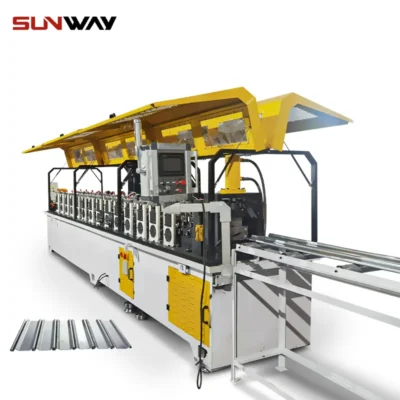 Kepenk Çıta Rulo Şekillendirme Makinesi
Kepenk Çıta Rulo Şekillendirme Makinesi -
 Otoyol Otokorkuluk Uç Terminali Şekillendirme Makinesi
Otoyol Otokorkuluk Uç Terminali Şekillendirme Makinesi -
 Otoyol U/C Post Rulo Şekillendirme Makinesi
Otoyol U/C Post Rulo Şekillendirme Makinesi -
 2 Dalga Otoyol Otokorkuluk Rulo Şekillendirme Makinesi
2 Dalga Otoyol Otokorkuluk Rulo Şekillendirme Makinesi -
 3 Dalga Otoyol Otokorkuluk Rulo Şekillendirme Makinesi
3 Dalga Otoyol Otokorkuluk Rulo Şekillendirme Makinesi -
 Elektrik Kabini Çerçeve Rulo Şekillendirme Makinesi
Elektrik Kabini Çerçeve Rulo Şekillendirme Makinesi -
 Din Ray Rulo Şekillendirme Makinesi
Din Ray Rulo Şekillendirme Makinesi -
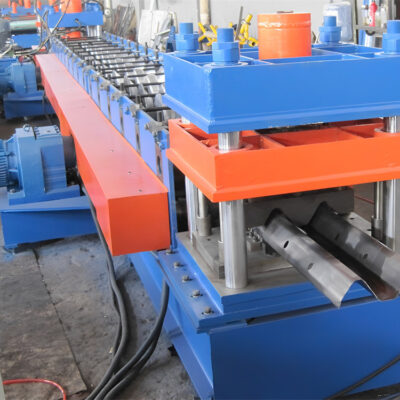 İki dalgalı otoyol korkuluk makinesi
İki dalgalı otoyol korkuluk makinesi -
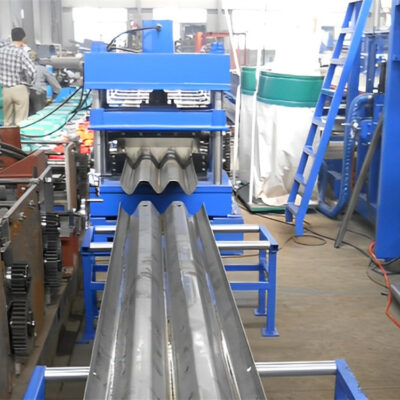 Üç dalgalı otoyol korkuluk makinesi
Üç dalgalı otoyol korkuluk makinesi
C Profil Yapma Makinesi Özelliklerine Daha Derin Bir Bakış
C profil üretim makinelerinin temel türlerini inceledikten sonra, onları farklılaştıran ve seçiminizi etkileyen belirli özellikleri daha derinlemesine inceleyelim:
- Rulo Şekillendirme İstasyonları: Rulo şekillendirme istasyonlarının sayısı, bir makinenin üretebileceği C profilinin karmaşıklığını doğrudan etkiler. Daha basit makineler altı istasyona kadar sahip olabilirken, sofistike modeller yirmiden fazla istasyona sahip olabilir. Daha fazla istasyon, karmaşık kıvrımlara ve şekillendirmeye olanak tanır, farklı açılarda flanşlara veya kanallar veya oluklar gibi ek özelliklere sahip profiller için idealdir.
- Malzeme Kalınlığı Kapasite: C profil makineleri, belirli bir kalınlık aralığındaki metal levhaları işlemek üzere tasarlanmıştır. Tipik makineler 0,5 mm ila 3,0 mm arasındaki çelik sacları işleyebilir, ancak bazı ağır hizmet modelleri daha kalın malzemeleri yönetebilir. İstediğiniz profil kalınlığına uygun bir makine seçmek çok önemlidir.
- Rulo Malzemesi: Merdanelerin malzemesi hayati bir rol oynar. Yüksek kaliteli sertleştirilmiş çelik merdaneler endüstri standardıdır ve aşınma ve yıpranmaya karşı dayanıklılık ve direnç sunar. Bazı makineler, özellikle aşındırıcı malzemelerle çalışırken daha uzun ömür için krom kaplı merdaneler kullanabilir.
- Besleme ve Kalkış Sistemleri: Besleme sistemi metal levhayı makineye verimli bir şekilde yönlendirirken, çıkarma sistemi bitmiş C profilini çıkarır. Otomatik besleme ve çıkarma sistemleri üretim verimliliğini artırır ve manuel kullanımı en aza indirir. Ayarlanabilir besleme hızları ve daha uzun profiller için istifleyici üniteler gibi özellikleri arayın.
- Kontrol Sistemleri: Modern C profil üretim makineleri sofistike kontrol sistemleriyle donatılmıştır. Bu sistemler, rulo hızı, basınç ve profil boyutları gibi parametreler de dahil olmak üzere şekillendirme süreci üzerinde hassas kontrol sağlar. Bazı gelişmiş makineler bilgisayar destekli tasarım (CAD) entegrasyonu sunarak karmaşık profillerin kolaylıkla oluşturulmasını sağlar.
Markalaşma ve Müşteri Hizmetlerinin Önemi
Teknik özellikler çok önemli olsa da, bir C profil üretim makinesi seçerken marka itibarının ve müşteri hizmetlerinin önemini göz ardı etmeyin. Kanıtlanmış bir geçmişe sahip köklü markaların güvenilir makineler, kolayca bulunabilen yedek parçalar ve kapsamlı satış sonrası destek sunma olasılığı daha yüksektir. Operatörleriniz için eğitim sağlayan ve ortaya çıkabilecek teknik sorunları ele almak için duyarlı bir müşteri hizmetleri ekibine sahip olan şirketleri arayın.
Önde Gelen C Profil Yapma Makinesi Üreticilerinden Örnekler:
İşte C profil üretim makinelerinin önde gelen üreticilerinden bazılarına bir bakış:
- Piranha Mühendislik: Yüksek hızlı, kullanıcı dostu silindir pres makineleri ile tanınır.
- Dahlih Makine: Hidrolik ve kompozit seçenekler de dahil olmak üzere kapsamlı bir C profil yapma makineleri yelpazesi sunar.
- Amada Makine: Yenilikçi ve teknolojik açıdan gelişmiş makineleriyle tanınan güvenilir bir marka.
Nihai bir karar vermeden önce farklı üreticiler hakkında kapsamlı bir araştırma yapmanın ve fiyat teklifleri talep etmenin çok önemli olduğunu unutmayın.
Doğru Seçimi Yapmak C Profil Yapma Makinesi
Doğru C profil yapma makinesini seçmek, özel ihtiyaçlarınızı ve proje gereksinimlerinizi dikkatlice değerlendirmeyi gerektirir. İşte size seçim sürecinde rehberlik edecek bir döküm:
- Profil İhtiyaçlarınızı Belirleyin: Üretmeyi düşündüğünüz C profilinin boyutunu, kalınlığını ve karmaşıklığını belirleyin. İstenen profili önceden çizmek yardımcı olabilir.
- Üretim Hacmini Değerlendirin: Üretmeniz gereken C profillerinin hacmini göz önünde bulundurun. Yüksek hacimli projeler, yüksek üretim hızlarına sahip makineler gerektirir.
- Bütçe Kısıtlamaları: Bütçeniz konusunda gerçekçi olun ve makineye ne kadar yatırım yapabileceğinizi belirleyin.
- Operatör Uzmanlığı: Operatörlerinizin beceri düzeyini değerlendirin. Karmaşık makineler daha deneyimli personel gerektirebilir.
- Satış Sonrası Destek: Mükemmel satış sonrası desteğe ve kolayca bulunabilen yedek parçalara sahip markalara öncelik verin.
Unutmayın, ideal C profil makinesi üretim sürecinizi kolaylaştıran, kaliteli çıktı sağlayan ve sağlıklı bir yatırım getirisi sunan bir yatırımdır.
C Profil Üretimi için Ek Hususlar
Makine şüphesiz en önemli unsur olsa da, başarılı C profil üretimi diğer birkaç önemli unsuru da kapsar:
- Yüksek Kaliteli Metal Bobinler: Kullandığınız metal sacın kalitesi nihai C profilini doğrudan etkiler. Tutarlı kalınlık ve özelliklere sahip bobinler sağlayan saygın çelik tedarikçilerini tercih edin.
- Yağlama: Merdanelerin düzgün şekilde yağlanması, sürtünme ve aşınmayı en aza indirerek sorunsuz çalışma için gereklidir. Metal şekillendirme uygulamaları için özel olarak formüle edilmiş yağlayıcılar kullanın.
- Bakım: Makinenin uzun ömürlü olmasını ve optimum performans göstermesini sağlamak için düzenli bakım çok önemlidir. Temizlik, yağlama ve ayarlamalar için üreticinin önerdiği bakım programını izleyin.
- Güvenlik Önlemleri: C profil yapma makineleri güvenlik tehlikeleri oluşturabilir. Operatörlerinizin güvenlik protokolleri konusunda uygun şekilde eğitildiğinden ve eldiven, koruyucu gözlük ve işitme koruması gibi uygun kişisel koruyucu ekipman (KKE) kullandığından emin olun.
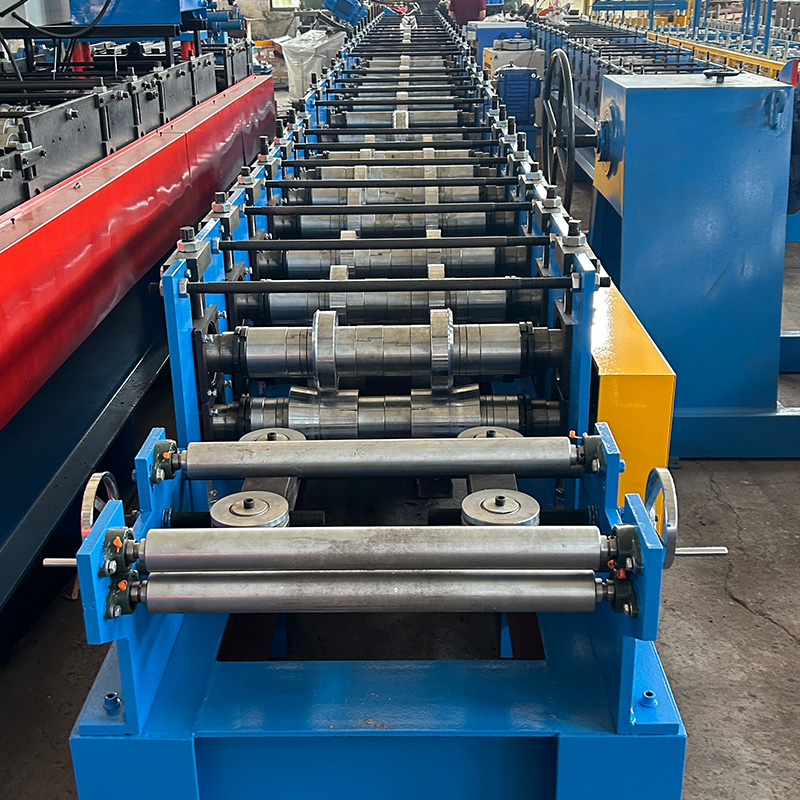
SSS
İşte C profil makineleri ile ilgili en sık sorulan sorulardan bazıları, açık ve bilgilendirici bir soru-cevap formatında sunulmuştur:
S: Bu makineler tarafından üretilebilecek tipik C profil boyutları nelerdir?
C: C profil makinelerinin boyut kapasiteleri modele bağlı olarak değişir. Genel olarak, makineler 50 mm ila 300 mm arasında değişen ağ yüksekliğine ve 20 mm ila 100 mm arasında flanş genişliğine sahip profiller üretebilir. Bununla birlikte, bazı ağır hizmet makineleri daha büyük boyutlara sahip profilleri işleyebilir. Düşündüğünüz makinenin teknik özelliklerine başvurmanız çok önemlidir.
S: Bu makineler çelik dışında başka malzemelerden de C profil üretebilir mi?
C: Çelik, C profilleri için kullanılan en yaygın malzeme olsa da, bazı makineler alüminyum ve hatta yüksek mukavemetli çelik alaşımları gibi diğer metalleri de işleyebilir. Bir makinenin belirli bir malzeme için uygunluğu, şekillendirme kabiliyetlerine ve malzemenin özelliklerine bağlıdır. Uyumlu malzemeler için daima üreticinin önerilerini kontrol edin.
S: Bu makineler ne kadar bakım gerektiriyor?
C: C profil yapım makinelerinin bakım gereksinimleri, makinenin karmaşıklığına ve kullanım sıklığına bağlı olarak değişir. Genel olarak, düzenli temizlik, yağlama ve ayarlamalar gereklidir. Çoğu üretici, kullanım kılavuzlarında ayrıntılı bakım programları sunmaktadır. Makinenin uzun ömürlü olmasını ve optimum performans göstermesini sağlamak için bu yönergelere uymak çok önemlidir.
S: Bir C profil yapma makinesini çalıştırırken hangi güvenlik önlemleri alınmalıdır?
C: C profil yapma makineleri doğru şekilde çalıştırılmazsa güvenlik tehlikeleri oluşturabilir. İşte uyulması gereken bazı temel güvenlik önlemleri:
- Doğru eğitim: Tüm operatörlerin acil durum kapatma prosedürleri de dahil olmak üzere makinenin güvenli çalışması konusunda kapsamlı bir şekilde eğitildiğinden emin olun.
- Kişisel koruyucu ekipman (KKE): Operatörler eldiven, koruyucu gözlük ve işitme koruması gibi uygun KKD'leri giymelidir.
- Bol giysiler ve takılar: Makineye dolanmayı önlemek için bol giysilerden ve takılardan kaçınılmalıdır.
- Koruma: Güvenlik koruyucularını daima yerinde tutun ve düzgün çalıştıklarından emin olun.
- Düzenli denetimler: Makinede herhangi bir hasar veya aşınma ve yıpranma belirtisi olup olmadığını düzenli olarak kontrol edin.
S: C profil yapma makineleri hakkında daha fazla bilgiyi nerede bulabilirim?
C: Çeşitli kaynaklar C profil yapma makineleri hakkında daha fazla bilgi sağlayabilir:
- Üretici web siteleri: Çoğu saygın C profil makinesi üreticisi, teknik özellikler, broşürler ve kullanım kılavuzları da dahil olmak üzere ürünleri hakkında ayrıntılı bilgi içeren kapsamlı web sitelerine sahiptir.
- Metal imalat endüstrisi yayınları: Metal imalat endüstrisine hitap eden ticari yayınlar ve çevrimiçi kaynaklar genellikle C profil üretim makineleri hakkında makaleler ve incelemeler içerir.
- Sektör dernekleri: American Metal Stamping Association (AMSA) veya Sheet Metal and Air Conditioning Contractors' National Association (SMACNA) gibi kuruluşlar değerli kaynaklar ve içgörüler sunabilir.


